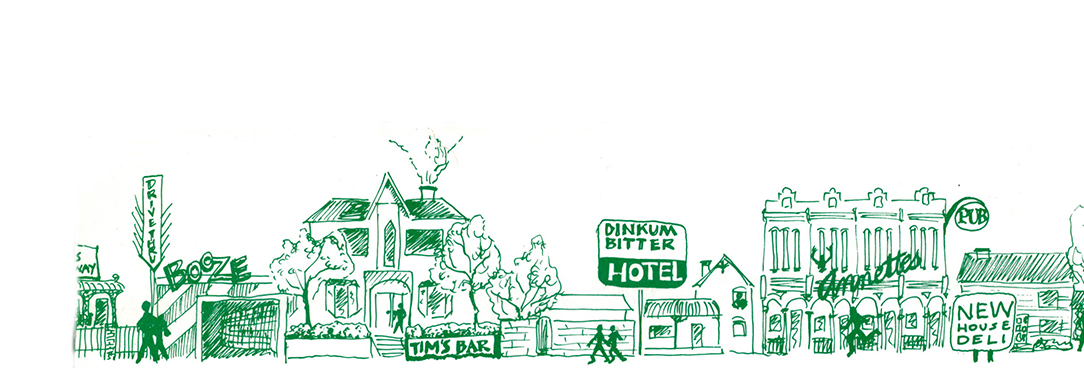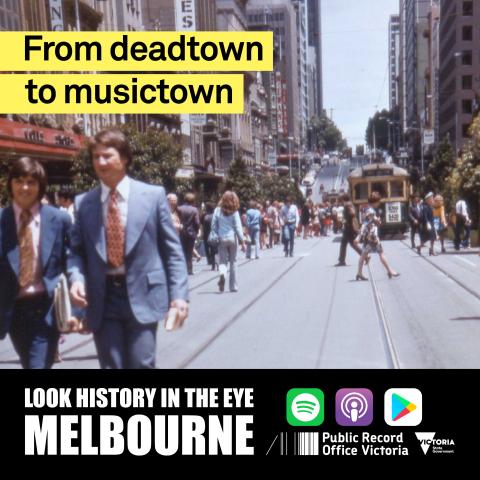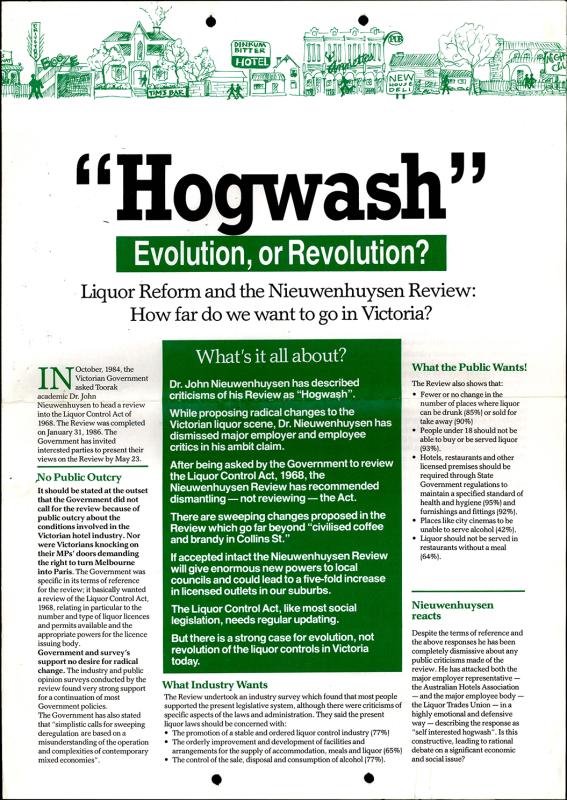Transcript Episode 4: From deadtown to musictown
From the podcast series 'Look history in the eye'
Written, produced and presented by Kate Follington and Public Record Office Victoria
Music and sound design by Jack Palmer
Guests: Michael Harden, Tiberio Donnini, and John Nieuwenhuysen
Kate Follington
Ah…Melbourne the cultural capital of the country, tourism campaigns like this one show laneways filled with people in summer drinking wine, dining outside under large umbrellas, squeezed into red brick alleyways surrounded by bright coloured graffiti art. People fly in from all over the country just to sample the restaurant scene. Melbourne hosts more live music gigs per capita than anywhere else in the world. More than London, New York and LA.
So what’s it worth? In 2017 the night time economy was worth 3.2 billion dollars.
Thirty years ago, 1980s Melbourne ….
Michael Harden
It was hilariously dead, people talk about on a Sunday playing cricket in the streets, because there was just nothing to do here. Everybody would go home, there were very few people living in the City, it really was an emptied out ghost town. I think people would be really surprised to know that Melbourne food culture as it exists right now is probably 20 years old.
That’s Michael Harden a food critic and writer on Melbourne culinary history.
Tiberio Donini
“I mean pubs were the go-to places. You could shoot a gun down the street in the 70s at 7pm on Lygon street and you wouldn’t kill anybody. Everything was done before 6pm, you drank everything and ate everything.”
Kate Follington
That’s Tobirio Donnini from the Donini family, who’ve been running Italian restaurants and wine bars in Melbourne since the 1950s.
Up until 30 years ago …Melbourne was a ghost town after dark… so who and what made it shift?
You’re listening to the Podcast “Look History in the Eye” produced by Public Record Office Victoria, the archive of the state government of Victoria. One hundred kilometres of public records about Victoria’s past are carefully preserved in climate controlled vaults. We meet the people who dig into those boxes, look history in the eye, and bother to wonder… why. You can download the record that began this story by searching ‘Look History in the Eye podcast’ online.
Kate Follington
A few months ago, I discovered a protest poster in some correspondence records from a local council. It’s not a poster about social justice or human rights – It’s about beer – it was folded neatly inside a manila folder of records catalogued under the title ‘Liquor Control Act’ the poster is quite large, white with green and black writing, the word “Hogwash!” in block letters is printed across the top – underneath it in dot points it accuses a man called John Nieuwenhuysen, of trying to cause a revolution in drinking habits in Melbourne. It claims people in Melbourne don’t want to be like Paris, they don’t want people to drink more after dark.
This is 1986, and the Australian Hotels Association was feeling the heat of change breathing down its neck – they needed to convince the public the only place for a civilised beer, was inside their hotels. And anyone who dared to suggest otherwise……was full of Hogwash!
How ironic. Have you ever wondered why old Australian pubs didn’t stop at the floors with tiles, but tiles right up the walls as well?
Between 1916 and the 1960s Hotels benefitted from one of the grossest and uncivilised drinking practices of any city in the world – it was known as the Six O’clock Swill.
Michael Harden
“The Six O’Clock swill originated after World War One. It was because they were worried soldiers couldn’t fight the Kaizer properly so they pulled it back to 6pm closing, a total disaster, and in terms of social engineering, people would binge drink, you couldn’t get a drink after 6, so mostly men, would pour out of their worksite and run to the pub and down as many beers as they could. It even effected the design of pubs, they were basically designed like a toilet block, everything was tiled, taps became spiggots on hoses so they could refill more glasses, so everyone would race in there, then tossed back out onto the streets, so all of a sudden at 6 O’clock, you’ve got legions of drunken men going out onto the city, and not great for the streets and not for their families when they got home.”
Kate Follington
In order to understand what truly made this shift, from ghost town to the most Livable City in the world in just a few decades, we have to go right back.
No alcohol after 6 went on for 50 years! Until 1967, So strange was this way of drinking that American soldiers during world war two were given videos to watch – so they could truly understand their Australian allies.
“Sometimes the beer is warm Dad, but they’ve had to get used to it this way. It was more like bargain counter than a bar, I’ve never seen so many people crammed into a small place. But these bars are only open a few hours a day.”
Europeans who moved here after the second world war were also understandably surprised they couldn’t drink alcohol with their meals at any café or restaurant that they wanted, so wine with a meal outside of a pub, had to be drunk in secret.
Michael Harden
“There was a famous one called Marios, which was run by the father of Meita O’Donnel, and they served a lot of wine, but they could only serve until 8pm, they could be raided at any time, the licencing police would be out sort of looking for anyone serving alcohol after 8 o’clock. And they would have big vases on the tables, and they’d post a lookout, and so if they saw the licensing police coming out at night they would pour wine into the vases. They would have wine in espresso cars, I knew they did that at Tiamo on Lygon street, red wine in coke bottles.”
Tiberio Donini
“We always found a way, we did get arrested a few times, I remember in 1978 / 1979 it was about ten past 3 on a Friday, two liquor licensing officers walked in, and we a table who were still there, and they still had alcohol on the table which was theirs. By the letter of the law we had to have all alcohol off the table by 3pm. Because the BYO permits went from a 12-3 and 6 to whatever …. I actually got charged. And went before the magistrate in Carlton just shook his head, and he just said this is crazy…even didn’t know that some silly law existed.”
Kate Follington
The hold that the Hotel industry had over the serving of alcohol was extreme, even after the 6pm swill was abandoned and hotels could serve alcohol until 10pm, restaurants still had restricted hours and conditions.
John Nieuwenhuysen
“The most privileged were the hotels, you could take away, you could drink with food, you could drink without food on the premises with food, but for all other licenses you had to go through all types of hoops in terms of facilities before you got that.”
Kate Follington
One way for the restaurants to get around the hoops was to have what was known as a “BYO license.”
A BYO license stood for Bring Your Own – it was cheap and their customers could bring as much alcohol as they like…. bought from….yep you guessed it…..a hotel’s bottle shop – but then they’d drink it at the restaurant. So in effect, even the BYO laws benefitted the hotels and not the restaurant industry.
Tiberio Donini
“ What happened to BYOs we were serving 100 people a night, and a table of 6 would come in with an esky, they would bring 6 bottles and we’d have to cool it for them, serve it for them, and not make a cent. The Chinese BYOs charged corkage in that era, and rightfully so. We thought it was a bit of a rip off but it became logistically impossible, there’d be people who would bring in pre-dinner drinks, their bottles of Port. So you knew you were in for a long one if they brought in their port, it was going to be a long night…”
But perhaps the biggest restriction related to liquor licensing was location - if a restaurant wanted to open on the same street as a hotel, the hotel would object to the application via the council.
The licensing officers behaved like bullies toward the hospitality industry – instead of nurturing a food economy, encouraging multicultural cuisine and serving of local wines – their number one job was to make it as difficult as possible for restaurants and bars to function. To restrict the sale of alcohol outside of the hotel industry.
Michael Harden
“The licensing court had huge powers, if they didn’t like the toilets or the colour of your carpet, the style of your menu or the font on your sign, they could deny you a license.”
Some places fostered a more European style of wine drinking and food experience, and luckily for Melbourne, the University of Melbourne staff would often go there as it was nearby their campus.
Tiberio Donnini
“The University, The Melbourne University the cultured society, the Professors, they were really forefathers of experimenting with wine, I used to enjoy their banter and chat and they used to teach me about Italian wines more than I even knew. That was more a late 70s and 80ths thing.”
Kate Follington
One of their regular guests was the economics professor John Nieuwenhuysen, the person at the centre of the smear campaign by the Hotel Association, used to drink bootleg alcohol at the University Cafe. The person full of ‘Hogwash’ – as the poster claimed. He knew first-hand the frustrations of people who wanted to drink outside of pubs, because he was one of them.
John Nieuwenhuysen
“When I first arrived in Australia, I came here as a lecturer in Economics at the Uni of Melbourne, September 1963 and I became friendly with some of the students, and she said let’s go and have a drink, and I said there’s nowhere to drink and she said I know a place. So we went to Lygon Street and we entered this café, where they had those plastic tapes hanging up where they stop the flies from coming in. And she said ‘we will have the usual please’, and he came out with two tea cups into which he had poured some warm sweet puffery pearl wine, he said ‘just watch the door while you drink’.”
John was an economics professor from South Africa who had helped the Government streamline their taxation system. What he knew about alcohol was limited, except he really liked it. In 1985 he received another call, this time from the Cain Government to review the liquor laws.
John Nieuwenhuysen
So I visited all sorts of different types of pubs, and restaurants, and the people who interested me the most were the restaurant owners. Because they were the ones with all these restrictions on them. They had to have special kinds of facilities, all types of toilets per person.
I made a lot of fun in my report about the Melbourne Restaurant Tram. Because, they were very interested in toilets at the commission, and on that tram one of the Judges boarded it and had lunch on it with a notebook, and he made notes about the number of times people went into the toilet. And that’s men and women, they liked to have it separate. Then he had to make a judgement on whether that tram got a license was based on their toilet facilities.
One of the highlights that my group never forgot, and we were driving around a small town, and we went to the pub and in rode rot have a license they’re obliged to provide you with food, there was 8 of us, so we went in and said we’d like to have lunch here today, and he said yes, I could give you lunch, but you are required for me, to give me 24 hour’s notice.”
Kate Follington
So the licensing system was strangling the ability for even some pubs to be able to perform their basic purpose let alone small bars or music venues which, in addition to not being able to serve alcohol after 10, were also bound by a food rule. In essence, if you wanted to have a band play at your venue, and wanted to serve alcohol, your clientele had to, by law, eat food with it. It became known as the Bona Fide Food rule.
Michael Harden
“They debated for two days whether or not pizza constituted a bona-fide meal.”
Kate Follington
The Hotels Association had a hold over the sale of alcohol in Victoria for almost 80 years, so its no wonder they were nervous about a review. Interestingly the review was requested by the new labour Premier John Cain, John Cain was in fact a non-drinker.
John Nieuwenhuysen
“The Hotels Association was very vigorous in their opposition to my report and had been so for donkey years, and they would give funds / donations to the political parties in power. In particular the liberal Government, Henry Bolte etc. They didn’t want to undermine the privileges of the hotel licenses. When my report was finally accepted January 1986 they accepted in the end 163 of the 187 recommendations, which is a good thing, the person who is responsible for this is John Cain. Which was quite surprising because John Cain had a reputation as a being a wowser.”
Kate Follington
The Hogwash poster wanted to try and argue the case that a looser licensee system would in turn increase drinking in our society. But the truth was, and the truth still is, that more alcohol is consumed at home, two thirds more in fact, than in bars or hotels according to a study by La Trobe University from a few years back. It’s your attitude to drinking that makes the difference, not a licensing problem.
John Nieuwenhuysen
The anti-alcohol people said that if you increase the number of outlets, you’ll increase the amount of drinking consumption. But, in Italy in those places and Switzerland where I’ve lived, you could go into a little grocery shop and there’s some bottles of wine on the shelf if you wanted to buy them. In Australia you had to go to a special shop for that. You could argue, if you can get wine at the supermarket, it means people have access to it and they’ll drink much more, but I said no, it’s the attitude to alcohol that is important, so those people who were drinking it at home on a daily basis were accustomed to going to small restaurant and having a glass of wine with their lunch or dinner. drinking it with their lunch or dinner – there wasn’t this constant fear what they would do if they didn’t have access to alcohol.
Kate Follington
John reduced 27 complex licenses down to 6, he suggested a simple on-premises license that allowed restaurants and bars to have a portion of their premises selling alcohol without food, they still needed a small kitchen but they could effectively serve alcohol without soggy weeners or old slices of pizza. The same license could be used by catering companies, music venues or sporting facilities, he recommended licensees be allowed to serve alcohol at any point during trading hours even if that’s extended hours, and created a unique license for liquor producers – for craft breweries and wineries, effectively paving the way for the boutique and local wine industry that’s booming now, He recommended cinemas be able to sell wine – something we now take for granted.
More than anything he removed anything else he removed the policing powers of the commission, handing it over to the police to concentrate on poor drinking behaviour, rather than how many toilets a restaurant had or what was considered a ‘bona fide meal’.
John Nieuwenhuysen
“The liberation through my report and the Act was to allow licensees to do business as they wanted to. When we did the report, there were three thousand licenses within 8-9 years there were 20 thousand licenses. So the industry responded marvellously, they said, give us this freedom and we’ll do it now, now in Melbourne you see now there a lot of little bars. Coming up all over the place still.”
Kate Follington
By the 90s Melbourne hit a recession and the City of Melbourne needed to do something fast to keep the city centre’s economy booming. The final step that has made Melbourne’s street music and bar scene the way it is today was about to happen. Basically what we now know as Laneway culture.
Michael Harden
“There was a huge amount of empty commercial space in Melbourne’s CBD, and so Melbourne City Council decided they’d try and do something about that, so they had an initiative to give young entrepreneurs people into the city and give them cheap subsidised rent, and they weren’t on the main streets, they were in the back alleyways, side streets etc, laneways as we know now no-one went down there, they were always considered a bit dangerous, but there was all this amazing space.”
Kate Follington
At the same time the Crown Casino was being built on south bank, and they swiftly lobbied the government to remove the need for any kitchen in any of their bars. So finally, in the 1990s, just over twenty years ago, Melburnians could finally open a bar that just served cocktails, negronis, martinis, specialise in boutique whisky, or fine gins, red wines, pisco sours or saki!
These entrepreneurial kids that were looking at moving into the laneways in the city and looked at it and went you beauty, it’s a cheap license, we don’t need the expense of a kitchen, we can just do a DIY punk thing, fit out the space and play the music we like. The first one was by an architecture company called Six Degrees, and they became very famous, their bar was nin Myer Place it was kind of ground zero for Melbourne bar culture, all recycled materials, they found a beer fridge that was from a house that was being demolished in Doncaster they were they were architects so good at design, so they sort of put a template in. and that changed everything.
Kate Follington
There you have it. Was John Nieuwenhuysen full of Hogwash?, as the poster would suggest, filed neatly among other Government Correspondence Records about the Liquor Act. Or did he simply, and bravely, pull back the hands of the hotel industry from strangling our city’s neck.
John Nieuwenhuysen
“When I went to a restaurant in the city, I think it was called Beckos, and the proprietor knew about the report and he gathered around him all his staff, and he said look at this man – it’s because of this man you have your job in your restaurant. They looked a bit non-plussed and one of them came up to me afterwards and said, was it different in your day?”
Links
Michael Harden, Meanjin. Unique and deplorable regulating drinking in Victoria. Volume 69, Number 3, 2010. https://meanjin.com.au/essays/unique-and-deplorable-regulating-drinking-in-victoria/
Sarah Callinan and Michael Livingstone, theconversation.com. bad behaviour and pubs is a problem but most of Australia’s alcohol is drunk at home. June 28, 2016. https://theconversation.com/bad-behaviour-in-bars-and-pubs-is-a-problem-but-most-of-australias-alcohol-is-drunk-at-home-56995
Paul Donoughue, ABC News. Melbourne is the live music capital of the world. 12 April 2018. https://www.abc.net.au/news/2018-04-12/melbourne-is-the-live-music-capital-of-the-world-census-shows/9643684
City of Melbourne. Food Sales dominate Melbourne’s late night economy. Media Release, 13 September 2018. https://www.melbourne.vic.gov.au/news-and-media/Pages/Food-sales-dominate-Melbourne%E2%80%99s-late-night-economy.aspx
Australian War Memorial. Love and War exhibition. Archival film clip, Australia is Like This. C 1944. https://www.youtube.com/watch?v=sm_CjWTKvI0&t=1s



